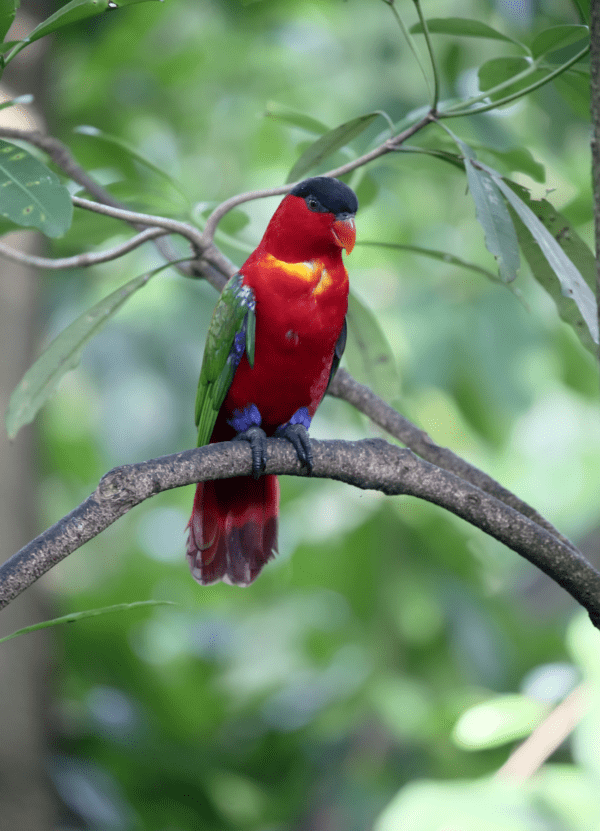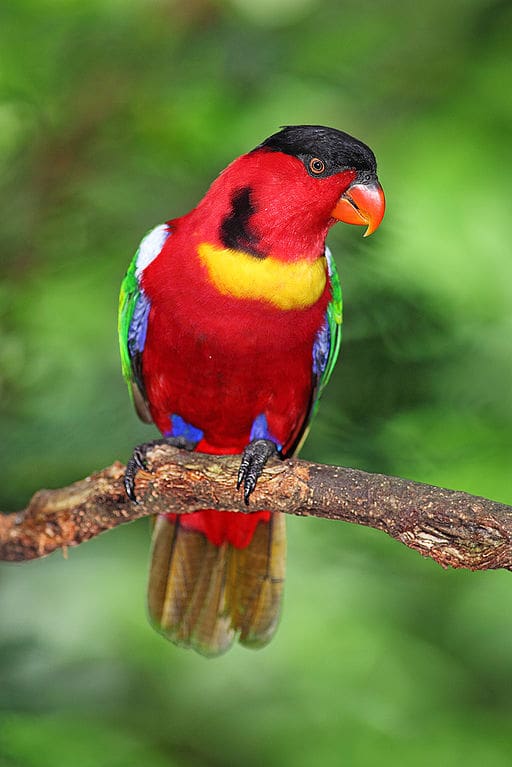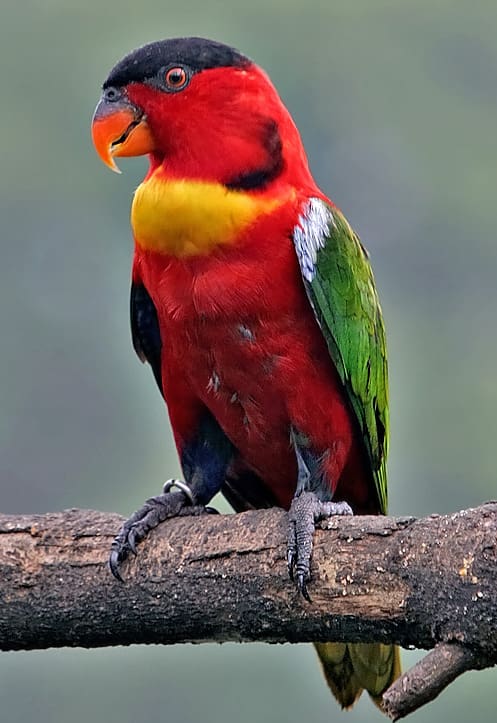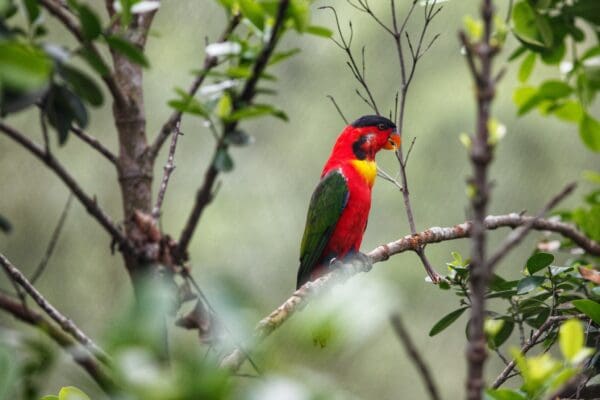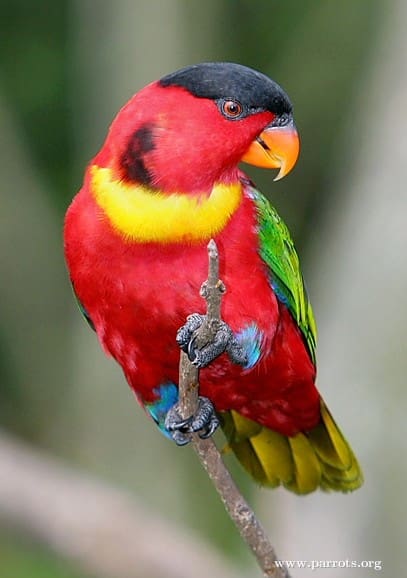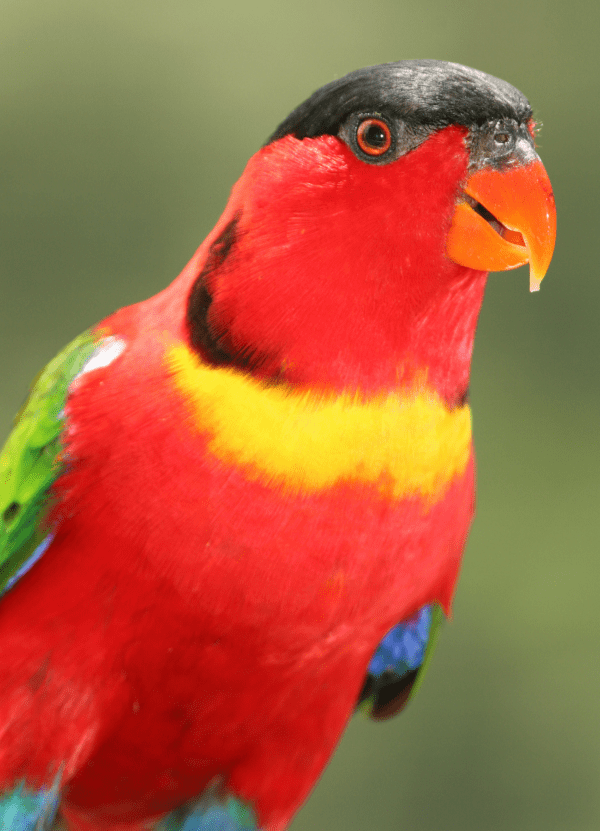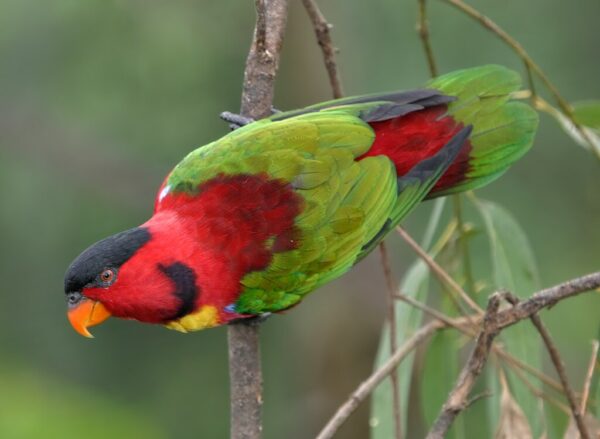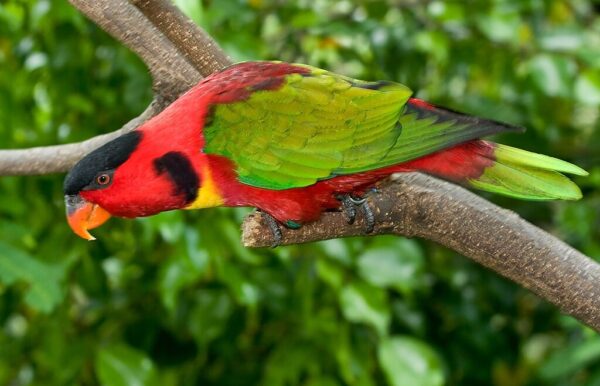Yellow-bibbed Lory
Also known as:
Green-tailed Lory, Gould's Lory
Also known as:
Green-tailed Lory, Gould's Lory
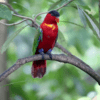
![© Benjamint444 (Own work) [GFDL 1.2] via Wikimedia Commons A Yellow-bibbed Lory perches on a branch](https://parrots.org/wp-content/uploads/2023/01/wpt_Yellow-bibbed-Lory_1243-8-100x100.jpg)
![© Doug Janson (Own work) [CC BY-SA 3.0 or GFDL] via Wikimedia Commons A Yellow-bibbed Lory perches on a branch](https://parrots.org/wp-content/uploads/2023/01/wpt_Yellow-bibbed-Lory_1243-7-100x100.jpg)
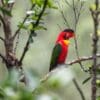
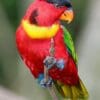
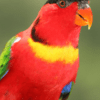
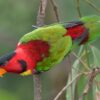
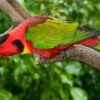
DID YOU KNOW?
The Yellow-bibbed Lory is highly skilled at mimicry.

Lorius

chlorocercus
Size:
28 cm (11 in)
Weight:
200 g (7 oz)
Subspecies including nominate:
one
Colour Adult:
Both adults in general bright red; black forehead and lores to occiput; crescent-shaped blue/black patch on each side of foreneck; upper breast has wide yellow band; purple/blue thighs; green wings; underwing stripe pink/red; red tail with wide green tips. Beak orange/red. Eye ring dark grey. Eye orange.
Colour Juvenile:
Yellow band on chest and markings on sides of foreneck minimal or absent. Thighs washed with green. Beak brown. Eye ring grey/white. Eye brown.
Call:
Calls are described as shrieking and harsh. While feeding emits soft chattering.
More Information:
Content Sources:
CITES
The Lory Link
BirdLife International
Cornell Lab of Ornithology/Birds of the World
Parrots: A Guide to Parrots of the World, Juniper and Parr, 1998
Parrots of the World, Forshaw and Cooper, 1977. 2010 edition
Parrots of the World, Forshaw, 2006.
Parrots in Aviculture, Low, 1992.
Lexicon of Parrots, Thomas Arndt.
Parrots: Their Care and Breeding, Low, 1986.
Captive Status:
Rare
Longevity:
25-35 yrs
Housing:
Enclosure with well-drained floor of concrete, with outlet hole or pebbles, or suspended cage over concrete floor.
Diet:
Nectar made from a mixture of lactose-free baby cereal, honey and malt extract or molasses, mixed with filtered water and made fresh once or twice daily, or a commercial type nectar, comprising at least 40 percent of the diet; fruits such as apple, pear, banana, pomegranate, cactus fruits, orange; vegetables such as: carrot, fresh corn on the cob or tinned, unsalted sweet corn; green leaves such as: Swiss chard, lettuce, dandelion, sowthistle or chickweed; dried figs soaked in water for a few hours; spray millet; small amount of soaked or sprouted sunflower seed and a small amount of canary seed and/or oats.
Enrichment:
Bathing using overhead misters or shallow water bowls, puzzle/foraging toys, noise-makers (bells), ladders, swings, ropes; plus bird-safe plastic toys that are easily cleaned.
Nest Box Size:
—
Clutch Size:
2
Fledging Age:
Probably 10-11 weeks.
Hatch Weight:
—
Peak Weight:
—
Weaning Weight:
—
World Population:
Unknown but described as relatively common. Decreasing.
IUCN Red List Status:
Least Concern
CITES Listing:
Appendix II
Threat Summary:
Not globally threatened. A BirdLife “restricted-range” species. Is suspected to be declining due to ongoing deforestation and capture for trade. Data from Global Forest Watch (2021) suggest that from 2001-2020 the species’ range experienced an increased loss of forest cover. The species is traded internationally and data from CITES (2021) suggest that the level of trade has jumped in recent years. It is also traded domestically in large numbers. The species is still relatively abundant in forest habitat, at least on Guadalcanal and Malaita, although it is rare on Rennell.
Range:
E Solomon Islands, from Savo and Guadalcanal to San Cristobal and Rennell.
Habitat:
Found up to 1000 m (3280 ft) in forest canopy and secondary growth. Also found around coconut plantations.
Wild Diet:
Diet includes pollen, nectar, fruits, small seeds and caterpillars.
Ecology and Behaviour:
Usually seen singly, in pairs or in groups of up to 10 individuals. Fairly tame and approachable. Feeds quietly in canopy.
Clutch and Egg Size:
2 elliptical eggs, 30.0 x 24.0 mm (1.2 x 0.9 in).
Breeding Season:
Not recorded.
